
- Published on
- Authors

- Name
- You
The Concept of Ka: Breath and Life Force in Ancient Egypt
In the vast panorama of ancient civilizations, the Egyptians stand out for their intricate belief systems and unique understanding of the human spirit and the afterlife. Among the various elements that composed an individual's existence, the 'Ka' holds a singular place of significance.
The Ka, often translated as "life force" or the "spiritual double," was thought to be born with an individual and represented the vital essence that accompanied them throughout their life and into the afterlife. In this exploration, we will delve into the concept of Ka, its intrinsic connection to breath, and its role in the continuity of life and vitality according to Ancient Egyptian belief.
Understanding Ka: Definitions and Significance
The word 'Ka' in Egyptian hieroglyphs is often depicted by two upraised arms, signifying sustenance, protection, and embracing an individual's life force. It was a spiritual entity that existed alongside a person's physical form, akin to what we might today consider as the soul or spirit. The following table outlines the essential facets of Ka and its manifestations across life's stages:
| Aspect | Description |
|---|---|
| Vitality | Represents the vital essence or life force, crucial for both physical and spiritual well-being. |
| Birth | The Ka is believed to be born simultaneously with an individual, bestowed by divine decree. |
| Sustenance | It requires nourishment in the afterlife, commonly provided through offerings and rituals. |
| Afterlife | Merges with the Ba (another soul aspect) to ensure immortality and eternal presence. |
Breath and Vitality: The Breath of Life
The Ancient Egyptians deeply interlinked the concept of Ka with breath, viewing breathing as a fundamental act that imparted life. This connection underscores the fundamental belief that breath (Shu) is the force that sustains the Ka. The act of breathing in this context transcends mere physical necessity and enters the realm of spiritual ritual.
Breath Rituals and Practices:
- Daily Offerings: Pharaohs and priests performed daily rituals that included offering food, drink, and incense to nourish the Ka of both the living and the deceased.
- Prayer and Incantations: Recitations of sacred texts were believed to infuse the breath of the speaker with divine energy, sustaining the Ka.
- Incorporation in Art: Visual representations often depicted individuals inhaling the breath of life from deities, emphasizing the sustenance of their Ka.
Integration of Advanced Scientific Understanding
While the mystical and religious undertones of the Ka characterized ancient beliefs, modern science provides a fresh perspective on these ancient concepts. The study of human physiology reveals that breath is indeed pivotal for life, supplying oxygen necessary for cellular function and the production of ATP, the energy currency of the body. This biological process mirrors the ancient wisdom that equated breath with life.
Ka and Modern Interpretations: Bridging Ancient and New Age Beliefs
Today, many spiritual practices, such as mindfulness breathing techniques and meditation, resonate with the Egyptian understanding of breath as a conduit for vitality and well-being. By examining the Ka through both historical and modern lenses, we find a timeless principle: the breath is not merely a physical act but a profound, life-sustaining force.
| Modern Parallel Practices | Ancient Egyptian Beliefs |
|---|---|
| Mindful Breathing Techniques | Breath as the sustainer of Ka |
| Meditative Practices on Life Energy | Ritual prayers and offerings to nourish Ka |
| Holistic Health Approaches | Integrated view of physical and spiritual well-being |
Conclusion
The concept of Ka in Ancient Egyptian belief beautifully blends the lines between mysticism and practicality. Understanding Ka as the life force interconnected with breath offers us a rich, symbolic insight into how the ancient Egyptians viewed existence. Whether viewed through the lens of ancient wisdom or modern scientific inquiry, the fundamental essence remains clear: the breath is a cornerstone of life, worthy of reverence and conscious integration into our daily existence.
Through this exploration of the Ka, we not only honor an ancient tradition but also affirm the continuing relevance of these age-old insights in contemporary spiritual and scientific paradigms.
